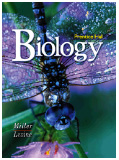BIOLOGY
by Miller & Levine
[complete Table of Contents]

|
Use the pull-down menu to jump to any of the Book's 40 Chapters: |
Additional Resources:
![]() Chapter 30
Chapter 30 ![]()
NONVERTEBRATE
CHORDATES, FISHES, AND AMPHIBIANS
In this chapter, students will read about the general characteristics of chordates and the specific adaptations of two groups of chordates—fishes and amphibians.. The links below lead to additional resources to help you with this chapter.
| Hot Links | Chapter Self-Test |
| Take it to the Net | Teaching Links |
What are Web Codes? |
Web
Codes for Chapter 30: |
![]()
Section
30-1: The Chordates
![]() A chordate is
an animal that has, for at least some stage of its life, a dorsal, hollow
nerve cord; a notochord; pharyngeal pouches; and a tail that extends beyond
the anus.
A chordate is
an animal that has, for at least some stage of its life, a dorsal, hollow
nerve cord; a notochord; pharyngeal pouches; and a tail that extends beyond
the anus.
![]() The two groups
of nonvertebrate chordates are tunicates and lancelets.
The two groups
of nonvertebrate chordates are tunicates and lancelets.
Section
30-2: Fishes
![]() Fishes are aquatic
vertebrates that are characterized by paired fins, scales, and gills.
Fishes are aquatic
vertebrates that are characterized by paired fins, scales, and gills.
![]() The evolution
of jaws and the evolution of paired fins were important developments during
the rise of fishes.
The evolution
of jaws and the evolution of paired fins were important developments during
the rise of fishes.
![]() Fishes' adaptations
to aquatic life include various modes of feeding, specialized structures
for gas exchange, and paired fins for locomotion.
Fishes' adaptations
to aquatic life include various modes of feeding, specialized structures
for gas exchange, and paired fins for locomotion.
![]() On the basis of
their basic internal structure, all living fishes can be classified into
one of three groups: jawless fishes, cartilaginous fishes, and bony fishes.
On the basis of
their basic internal structure, all living fishes can be classified into
one of three groups: jawless fishes, cartilaginous fishes, and bony fishes.
Section
30-3: Amphibians
![]() An amphibian is
a vertebrate that, with some exceptions, lays eggs in water, lives in
water as a larva and on land as an adult, breathes with lungs as an adult,
has moist skin that contains mucus glands, and lacks scales and claws.
An amphibian is
a vertebrate that, with some exceptions, lays eggs in water, lives in
water as a larva and on land as an adult, breathes with lungs as an adult,
has moist skin that contains mucus glands, and lacks scales and claws.
![]() Early amphibians
evolved several adaptations that helped them live at least part of their
lives out of water. Bones in the limbs and limb girdles of amphibians
became stronger, permitting more efficient movement. A set of lungs and
breathing tubes enabled them to breathe air. Their sternum formed a bony
shield that supports and protects the internal organs, especially the
lungs.
Early amphibians
evolved several adaptations that helped them live at least part of their
lives out of water. Bones in the limbs and limb girdles of amphibians
became stronger, permitting more efficient movement. A set of lungs and
breathing tubes enabled them to breathe air. Their sternum formed a bony
shield that supports and protects the internal organs, especially the
lungs.
![]() The three groups
of living amphibians are salamanders, frogs and toads, and caecilians.
The three groups
of living amphibians are salamanders, frogs and toads, and caecilians.